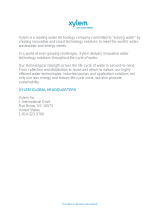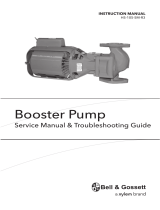Page is loading ...

OPERATIONS MANUAL
ba76136e04 10/2017
4120(W) / 4130(W)
PH COMBINATION ELECTRODES WITH REFILLABLE LIQUID REFERENCE SYSTEM

2 ba76136e04 10/2017
4120(W) / 4130(W)
Contact YSI
1725 Brannum Lane
Yellow Springs, OH 45387 USA
Tel: +1 937-767-7241
800-765-4974
Email: environme[email protected]
Internet: www.ysi.com
Copyright © 2017 Xylem Inc.

4120(W) / 4130(W) General information
3
ba76136e04 10/2017
1 General information
Automatic sensor
recognition
The sensor electronics with the stored sensor data are in the connecting
head of the electrode. The data include, among other things, the sensor type
and series number. In addition, the calibration data are stored in the sensor
with each calibration and the calibration history is recorded (the last 10 cali-
brations). The data is recalled by the meter when the sensor is connected
and is used for measurement and for measured value documentation.
Storing the calibration data in the sensor ensures that the correct slope and
asymmetry are automatically used if the sensor is operated with different
meters. On the other hand, different calibrated sensors can be used with one
meter without the need to recalibrate.
The digital transmission technique guarantees the failure-free communica-
tion with the meter even with long connection cables. The sensor firmware
can be updated via the meter.
2 Commissioning, measuring, calibration
2.1 Commissioning
Scope of delivery Electrode 4120(W) / 4130(W)
Operating manual
Commissioning The electrode is filled with reference electrolyte solution in the factory. Pre-
pare the electrode for measuring as follows:
Open the refilling opening for the reference electrolyte solution. Depend-
ing on the model, the stopper of the refilling opening is an elastomer stop-
per or a slider.
The refilling opening must always be open during calibration and
measurement!
Remove the watering cap from the electrode tip. Possible salt deposits in
the area of the watering cap do not affect the measuring characteristics
and can easily be removed with deionized water.
Refilling
opening
Refilling
opening
2
1

Commissioning, measuring, calibration 4120(W) / 4130(W)
4
ba76136e04 10/2017
4120(W): Remove any gas bubbles behind the pH membrane by shaking.
Connect the electrode to the meter.
Calibrate the electrode according to the operating manual of the meter
and observe the following rules while doing so:
2.2 Opening and closing the IDS plug connection
This section only applies to IDS plug variants (41x0W).
Please keep the watering cap. It is required for the electrode to
be stored. Always keep the watering cap clean.
4120 /4130 – via the sensor cable to a free IDS connec-
tor on the meter
4120W/4130W – via a connecting cable (accessory) to a
free IDS connector on the meter
or
– wireless via an IDS WA-S adapter (acces-
sory) to a WA-capable meter
Accessories for the connection of the 41x0W
sensor to the meter: See chapter 7 W
EAR
PARTS AND ACCESSORIES.
Opening and closing the IDS plug connection,
see section 2.2 O
PENING AND CLOSING THE
IDS
PLUG CONNECTION.

4120(W) / 4130(W) Commissioning, measuring, calibration
5
ba76136e04 10/2017
Opening the plug
connection
If necessary, clean the plug connection.
Open the locking device (step 1).
Use your thumb and index finger to press the clips of the connector
together, and pull the connector out of the plug (step 2).
Closing the plug
connection
Make sure that the plug connection is completely dry and clean.
Align the guidance of the connector with the groove in the plug and insert
the connector in the unlocked plug until it catches (step 3).
Close the locking device (step 4).
2.3 Calibration and measurement: General rules
Make sure the refilling opening for the reference electrolyte solution is
open.
Avoid the carryover of any solution (sample or buffer solution) from one
2
4
3
1
Plug connection
closed and locked
Guidance
Groove

Storage 4120(W) / 4130(W)
6
ba76136e04 10/2017
measurement to the next by taking the following measures:
– Shortly rinse the calibration and sample beakers with the solution the
beakers are to be filled with next.
– Between measurements, rinse the electrode with the solution that fol-
lows. Alternatively, you can also rinse the electrode with deionized
water and then carefully dab it dry.
Immerse the electrode in the solution in a vertical or slightly tilted position.
Make sure the immersion depth is correct. The junction must be com-
pletely submersed in the solution. The junction is in the area of the bottom
end of the shaft (see figure). At the same time, the level of the reference
electrolyte in the electrode must be at least 2 cm above the level of the
solution.
Provide approximately the same stirring conditions for measuring as for
calibrating.
Subsequent
calibrations
The frequency of subsequent calibrations depends on the application. The
meters provide an option where you can enter a calibration interval. After the
calibration interval has expired, the meter will automatically remind you of the
due calibration.
3Storage
During short
measuring breaks
With the refilling opening open, immerse the electrode in reference electro-
lyte (KCl 3 mol/l, Ag
+
free). Prior to the next measurement, shortly rinse the
electrode with the test sample or deionized water.
Overnight or
longer
Put the clean electrode in the watering cap that is filled with reference elec-
trolyte (KCl 3 mol/l, Ag
+
free) and close the refilling opening.
Prevent contact of the pH membrane to the beaker bottom to
avoid scratches on the pH membrane.
Junction
Reference electrolyte
(Example)
Glass membrane
Shaft
Prevent contact of the pH membrane to the beaker bottom to
avoid scratches on the pH membrane.

4120(W) / 4130(W) Aging
7
ba76136e04 10/2017
NOTE
pH electrodes must not be stored dry or in deionized water. The elec-
trode could be permanently damaged by this. If the liquid in the
watering cap has dried up, condition the electrode in reference electro-
lyte (KCl 3 mol/l, Ag+ free) for at least 24 hours.
4 Aging
pH electrodes are consumables. Every pH electrode undergoes a natural
aging process. With aging, the responding behavior becomes slower and the
electrode slope and asymmetry change. Moreover, extreme operating condi-
tions can considerably shorten the lifetime of the electrode. These are:
Strong acids or lyes, hydrofluoric acid, organic solvents, oils, fats, bro-
mides, sulfides, iodides, proteins
High temperatures
High changes in pH and temperature.
The warranty does not cover failure caused by measuring conditions and
mechanical damage.
5 Maintenance and cleaning
Refilling the
reference
electrolyte
During operation, a small amount of reference electrolyte leaks through the
junction from the electrode into the test sample. If the level of reference elec-
trolyte becomes too low with time, refill it through the refilling opening. Refill-
ing is very easy with the enclosed dropping bottle. Proceed as follows:
Cut off the tip of the dropping bottle at a right angle until the opening in the
tip can be seen
Open the refilling opening of the electrode
Press the tip of the dropping bottle into the refilling opening while turning
it slightly
Pump the reference electrolyte in the shaft using the dropping bottle
Pull the dropping bottle out of the refilling opening while turning it slightly
as necessary.
During longer storing periods, salt sediments may develop on the
watering cap. They do not affect the measuring characteristics
and can easily be removed with deionized water when the elec-
trode is put into operation again.

Technical data 4120(W) / 4130(W)
8
ba76136e04 10/2017
Cleaning Remove water-soluble contamination by rinsing with deionized water.
Remove other contamination as follows:
NOTE
Hydrofluoric acid, hot phosphoric acid and strong alkaline solutions
destroy the glass membrane.
After cleaning Rinse the electrode with deionized water and condition it in reference elec-
trolyte solution for at least 1 hour. Then recalibrate the electrode.
6 Technical data
Contamination Cleaning procedure
Fat and oil Rinse with water containing household wash-
ing-up liquid
Lime and hydroxide deposits Rinse with citric acid (10 % by weight)
Measurement pH measuring range 0.000 ... 14.000
Allowed temperature range
(°C)
0 ... 80 °C (4120(W))
0 ... 100 °C (4130(W))
Allowed temperature range
(°F)
32 ... 176 °F (4120(W))
32 ... 212 °F (4130(W))
Accuracy of the
IDS measuring
technique
Measured parameter Accuracy (± 1 digit)
pH ± 0.004
U [mV] ± 0.2
T [°C] ± 0.1

4120(W) / 4130(W) Technical data
9
ba76136e04 10/2017
General features Reference electrolyte KCl 3 mol/l, Ag
+
free
Junction Ceramic (4120(W))
Platinum (4130(W))
Temperature sensor Integrated NTC 30
(30 kat 25 °C / 77 °F)
Connection cable Lengths 4120(W) / 4130(W): 1,5
4120(W) / 4130(W)W:1,5 / 3 m
Diameter 4.3 mm
Smallest allowed
bend radius
Fixed installation:20 mm
Flexible use:60 mm
Plug type Socket, 4 pins
Shaft dimensions,
material
Shaft length 120 mm (4120(W))
Shaft diameter 12 mm (4120(W))
Shaft material Polyamide (4120(W))
Glass (4130(W),
IDS plug Synthetic materials: Glass fiber reinforced
Noryl, TPU, TPC-ET, POM, PVC, PEEK,
PBT
O-ring: FPM
Contacts gold-Plated
IDS plug Connection type 4-Pole, watertight plug connection with lock,
reverse polarity protected
Storage With watering cap; filled with KCl 3 mol/L, Ag
+
free
Model Reference electrolyte Junction NTC Special
features
Double
junction
4120 KCl 3 mol/l, Ag
+
free Ceramic Yes Plastic shaft Yes
4130 KCl 3 mol/l, Ag
+
free Platinum Yes Yes

Wear parts and accessories 4120(W) / 4130(W)
10
ba76136e04 10/2017
7 Wear parts and accessories
8 Disposal
At the end of its operational lifetime, the electrode (electronic waste) must be
returned to the disposal or return system statutory in your country (electronic
waste). If you have any questions, please contact your supplier.
Maintenance
equipment
Description Model Order no.
Reference electrolyte solution 250 ml
to fill the watering cap
(KCl 3 mol/l, Ag
+
-free)
KCl-250 109 705Y
Connection cable
4120(W) / 4130(W) -
meter
Description Model Order no.
IDS connection cable, 1.5 m IDS-CABLE-
1.5
903 850Y
IDS connection cable, 3 m IDS-CABLE-3 903 851Y
Radio connection
4120(W) / 4130(W) -
meter
Description Model Order no.
WA capable IDS meter
+ radio module for IDS meter
see Internet
Radio module for plug head sensor IDS WA-S 108 141Y

4120(W) / 4130(W) Contact Information
11
ba76136e04 10/2017
Contact Information
Ordering & Technical Support
When placing an order please have the following information available:
Service Information
YSI has authorized service centers throughout the United States and
Internationally. For the nearest service center information, please visit
www.ysi.com
and click ‘Support’ or contact YSI Technical Support
directly at 800-897-4151.
When returning a product for service, include the Product Return form
with cleaning certification. The form must be completely filled out for an
YSI Service Center to accept the instrument for service. The Product
Return form may be downloaded at www.ysi.com
and clicking on the
‘Support‘ tab.
Telephone
: (800) 897-4151
(937) 767-7241
Monday through Friday, 8:00 AM to 5:00 PM ET
Fax
: (937) 767-1058
Email
Mail: YSI Incorporated
1725 Brannum Lane
Yellow Springs, OH 45387
USA
Internet
: www.ysi.com
YSI account number (if available) Name and Phone Number
Model number or brief description Billing and shipping address
Quantity Purchase Order or Credit Card

Contact Information 4120(W) / 4130(W)
12
ba76136e04 10/2017


1) The tissue in plants that brings water upward from the roots;
2) a leading global water technology company.
We're 12,500 people unified in a common purpose: creating innovative solutions
to meet our world's water needs. Developing new technologies that will improve
the way water is used, conserved, and re-used in the future is central to our work.
We move, treat, analyze, and return water to the environment, and we help people
use water efficiently, in their homes, buildings, factories and farms. In more than
150 countries, we have strong, long-standing relationships with customers who
know us for our powerful combination of leading product brands and applications
expertise, backed by a legacy of innovation.
For more information on how Xylem can help you, go to www.xyleminc.com
Xylem |' m|zīlə
YSI
1725 Brannum Lane
Yellow Springs, OH 45387
Tel: +1 937-767-7241; 800-765-4974
Fax: +1 937-767-1058
Email: envir[email protected]
Web: www.ysi.com
©Xylem Inc
/


